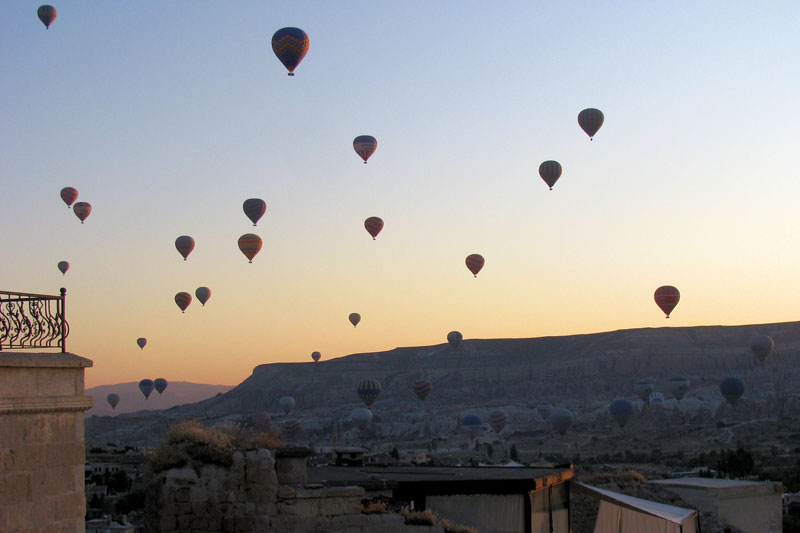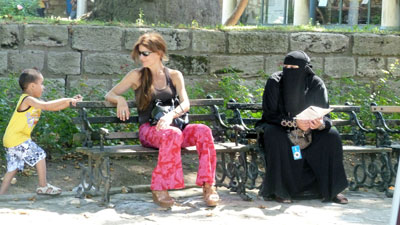Tips for first-time visitors to Turkey
After my wife, Paula, and I and another couple traveled in Turkey in September ’11, I compiled information and tips on some topics that weren’t addressed or I felt weren’t emphasized enough in the guidebooks and Internet resources we consulted prior to our trip. I also have some recommendations.
FOOD AND DRINK — We ate healthier meals on this trip than on any other trip we’d taken! Fresh vegetables, salads and fruits were abundant and delicious. The fish was fresh and tasty, while the meat (usually lamb, veal or chicken but, of course, no pork) was lean. The yogurts and teas were excellent.
Restaurant prices were lower than we expected them to be, especially outside of Istanbul and away from touristy areas. Per person, we usually paid less than $10 for lunch and, for dinner, $15 outside Istanbul and less than $20 within Istanbul. Bottled still water usually was available at no extra charge. These prices did not include alcoholic beverages.
The local wines (especially the reds) and beers were quite good and reasonably priced. We tried wines ranging from $10 to $30 a bottle. A generous pour of wine by the glass cost about $5. The most common beer, Efes, was available in half-liter bottles for only TRY1 (near 55¢) or TRY2.
Most travelers don’t drink the tap water. Bottled water was widely available in 1½-liter bottles for only one or two Turkish liras.
FLYING IN TURKEY — Boarding for two of our three flights within Turkey was a chaotic rush for the gate when it opened, despite our boarding passes’ indicating we would board by group.
Coach class had more legroom and luggage room than is common on US domestic flights. This was true both on Turkish Airlines and on a budget airline, Sun Express.
Turkish Airlines served a decent, free meal even on a flight as short as an hour and a quarter.
On our transatlantic flights as well as our internal flights in Turkey, we saved a few hundred dollars by buying the tickets through an agency within Turkey, Turkish Heritage Travel (Göreme, Nevs¸ehir, Turkey; phone +90 384 271 2687, fax 271 2699, www.goreme.com).
To find an agent there, I began with my primary trip-planning tool, the latest Lonely Planet guide. I noted the agencies recommended in the guide, then checked their websites to learn what they offered and how much they charged for their services. I also checked TripAdvisor.com for feedback on those agencies.
Our airfare purchases were in Turkish liras. My credit card company added its usual currency-conversion charge to the transaction.
ISTANBUL — It’s harder to find your way around Istanbul on foot than you might expect. The roads are narrow, often are not marked with street signs and rarely offer open vistas that would allow you to navigate using major landmarks. If you plan on exploring off the beaten path, I recommend investing in a good map instead of depending on a simple tourist map.
Many recommended hotels are located in an area downhill from the Blue Mosque and Hagia Sophia. We found that district to be overly touristy and noisy at night. While some of the hotel rooftop terraces there offer good views of the Sea of Marmara and the Princes’ Islands, hotels located on higher ground offer better views.
The rooftop terrace at the hotel we used, the Adamar (Yerebatan Caddesi #47, Sultanahmet, Istanbul; phone +90 212 511 19 36, fax 513 95 48), had wonderful views of Hagia Sophia and the Blue Mosque, Bosphorus Bridge and Golden Horn. Including a 5% Rick Steves discount, we paid €123 (near $158) per night for a standard double room.
When you visit Hagia Sophia, you might see two lines at the entrance. The shorter line will likely be the one that’s only for Turkish citizens.
Beginning at sunset, the Bosphorus Bridge puts on an entertaining light show that’s worth seeing.
The underrated Museum of Turkish & Islamic Arts (across from the Hippodrome’s Egyptian Obelisk) is definitely worth visiting, despite its limited air-conditioning. In addition to the expected art and relics, the museum has an ethnographic portion with fascinating re-creations of Turkish homes of different eras. After seeing the exhibits, spend some time relaxing at one of the tables on the museum’s tranquil terrace overlooking the Hippodrome and Blue Mosque.
In any area frequented by tourists, expect touts in front of some restaurants as well as plenty of touts for carpet shops at unexpected locations (not just at shop entrances). These touts can be very annoying and very persistent. I was surprised by how openly rude some of them were once it was clear that I wasn’t buying what they were selling.
In Istanbul, there are several restaurants with pleasant outdoor seating along Ticarethane Sokak. Those near the street’s northern end are quieter. What was perhaps the least expensive of the lot, Anatolia Kebab House Café & Restaurant, at No. 61, offered several excellent dishes, though their wine list was disappointing. A meal, without wine, cost about $20 per person.
There was also an excellent and highly recommended carpet shop, Noah’s Ark, at No. 11 on this street.
CAPPADOCIA — Staying in a cave hotel is a unique and enjoyable experience. However, don’t expect your cell phone, WiFi or radio to work in your room. (Being surrounded by rock does have its disadvantages.)
Touring an underground city is recommended, but, since it can be a bit claustrophobic, it’s not for everyone. On a tour we took of Kaymaklı, about half of the people were compelled to cut the tour short to get back above ground. The underground city was surprisingly well illuminated and was, in my opinion, less claustrophobic than some of the tombs we’ve visited in Egypt. It was certainly much cooler than the Egyptian tombs.
Some of the hikes around Cappadocia can be more challenging than advertised. Maintaining your footing on steep descents on hard ground covered with a loose layer of slippery dust is not for the faint of heart. Wear good shoes. We noticed many sandal-wearing tourists with bandages on their toes.
On a positive note, along our hiking route through the Rose Valley there were two different stands offering drinks and snacks (and one with a WC) in unexpected places.
Everyone who took one of the many sunrise hot-air balloon rides was highly positive about the experience. There were dozens of balloons in the sky at sunrise above Goreme, where we stayed. Their pilots maneuvered the balloons lower to the ground and closer to the rock formations, called “fairy chimneys,” than I expect they would be allowed to do in the States.
The Lonely Planet-recommended Nazar Börek (Muze Yolu Caddesi #30), in Göreme, was an inexpensive place for a good meal (TRY5-TRY7 before drinks). Musicians played there during our lunch.
The roads were surprisingly good and traffic was light. Parking was not a problem. This region would be easy to explore with a rental car.
OTHER — I worked with the very patient and thorough Ms. Deniz Turgut of Turkish Heritage Travel to make all of the arrangements for the non-Istanbul portion of our vacation (and all of our flights, as I mentioned). Her advice resulted in our trip being more enjoyable and successful than it would have been otherwise. All of her arrangements (e.g., airport transfers) went off without a hitch.
We paid Turkish Heritage €1,060 ($1,514), 20% at booking and 80% after arriving in Turkey, for the following for Paula and me: three flights within Turkey; three nights’ lodging (including breakfast) in Göreme; one night’s lodging (with breakfast) in Selçuk; airport transfers (shuttle van) to and from Goreme; a full-day tour (as part of a group of about a dozen people) with lunch of Cappadocia; private airport transfers between Izmir and Selçuk (near Ephesus), and a private, half-day guided tour of Ephesus.
By the way, we found no services once we entered the historic city of Ephesus. The only WCs, shops with water and cafés were at the city’s entrances and exits.
We found Turkey to be clean (almost no litter or graffiti) and safe. We saw no dodgy neighborhoods. At no time did we feel in the least bit uncomfortable or unsafe.
STEPHEN O. ADDISON, Jr.
Charlotte, NC




